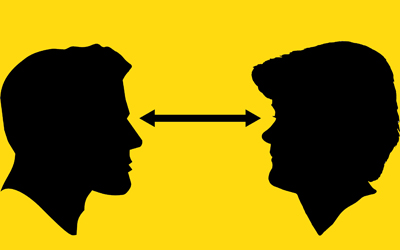
Body Language Secrets of Successful Negotiation
February 21, 2019Whether you’re negotiating a high-level contract with a supplier or trying to get your boss to OK a project, the way you present yourself is just as important as what you say.
In any business encounter (from high-stakes negotiation to everyday bargaining situations) you communicate over two channels—verbal and nonverbal—resulting in two distinct conversations going on at the same time. While a well-designed bargaining strategy is obviously important, it’s not the most important message you send. Communication research shows that in a 30-minute negotiation, two people can send over 800 different nonverbal signals. If you focus on the verbal exchange alone and ignore the nonverbal element, you stand a high chance of coming away from a negotiation wondering why in the world your brilliantly constructed bargaining plan didn’t work out the way it was supposed to.
HERE ARE FIVE BODY LANGUAGE GUIDELINES TO HELP YOU HOLD YOUR OWN WHEN YOU NEGOTIATE

1. Start off with the right stuff
It all begins with the right attitude. Regardless of how tiring or frustrating your day may have been, before you enter the meeting room, pull your shoulders back, hold your head high, take a deep breath, and walk in as your “best self,” exuding ease and energy.

Just after entering the meeting room, stop for a moment and look around at the person or group that has already assembled. Open your eyes slightly larger than usual. This will trigger an “eyebrow flash” (a slight upward movement that is a universal signal of recognition and welcome). Smile. Make eye contact with each of your counterparts. A simple way to enhance positive eye contact is to look at eyes long enough to know what color they are.

2. Shake hands
You can develop an immediate and positive connection with someone by simply shaking his hand—if you do it right! Here’s how:

- Whenever possible, initiate the handshake. Lean forward and extend your hand with your palm facing sideways.
- Keep your body squared off to the other person, facing him or her fully.
- Maintain eye contact and continue to smile.
- Make sure you have palm-to-palm contact and that the web of your hand (the skin between your thumb and first finger) touches the web of the other person’s.
- Press firmly. People will judge you as indecisive or weak if you offer a limp grip. However, don’t be overly aggressive and squeeze too hard.
- Hold the other person’s hand a second longer than you are naturally inclined to do. This conveys additional sincerity and quite literally “holds” the other person’s attention while you exchange greetings.
- Start talking before you let go: “It’s great to see you” or “I’m so glad to be here.” If you are meeting for the first time, introduce yourself.
- When you break eye contact, don’t look down (it’s a submission signal). Rather, keep your head up and move your eyes to the side.
3. Continue building rapport
In negotiations, rapport is the foundation for a “win-win” outcome. Everything you have done from the time you entered the room until now has been geared to send rapport-building nonverbal statements. To continue building rapport, remember to maintain eye contact, lean forward, use head nods of encouragement, and smile when appropriate.

The most powerful sign of rapport—and one that you already do (unconsciously) around people you like and respect—is to mirror the other person’s body postures, gestures, expressions, breathing pattern, and so on. Mirroring builds agreement, but if you use mirroring as a technique, be subtle. Allow two or three seconds to go by before gradually changing your body language to (more or less) reflect that of the other person.
4. Display confidence

Showing your torso is one way of demonstrating a high level of confidence, security, or trust. The more you cover your torso with folded arms, crossed legs, and so on, the more it appears that you need to protect or defend yourself. Feet also say a lot about your self-confidence. When you stand with your feet close together, you can seem timid or hesitant. But when you widen your stance, relax your knees and center your weight in your lower body, you look more “solid” and sure of yourself.
When you need to be seen as assertive, remember that power is displayed by height and space. If you stand you will look more powerful to those who are seated. If you move around, the additional space you take up adds to that impression. If you are sitting, you can still project power by stretching your legs and arms and by spreading out your belongings on the conference table, and claiming more territory.
5. Make a positive final impression
In the same way you conveyed energy and ease during your entrance and projected confidence throughout the negotiation process, be sure you also make a strong exit. Stand tall, shake hands warmly, and leave your counterpart with the impression that you are someone he or she should look forward to dealing with in the future.
Body Language Signals You Should Never Send in a Negotiation
Mistake #1: Scratching Your Head

When it comes to answering questions to which we do not immediately know the answer, our hands can reflexively spring to our heads. Stop now! Rubbing your head or neck makes your appear clueless and unsure of yourself – not the message you want to send if you are asking for a pay rise.
Mistake #2: Avoiding Eye Contact

Playing ping pong with your eyes is not a good look. Avoiding eye contact with your negotiating partner has the unfortunate effect of conveying nervousness and insecurity. Now is the time to show that thanks to your excellent preparation and outstanding efforts – you are completely in control!
Mistake #3: Hands in Your Pockets

Convincing words need to be backed up with the right body language. Putting your hands in your pockets conveys the message you have something to hide.
Mistake #4: Rubbing Your Neck
Even if you are tense – avoid rubbing your neck at all costs. It gives the impression of being disinterested or at a loss – not messages you want to be conveying in a negotiation!
Mistake #5: Tapping Your Fingers

You are nervous – while trying to avoid fidgeting with your arms and legs, you attempt something less noticeable. Stop! Tapping your fingers gives the impression of being impatient and in the worst case scenario could be interpreted as arrogance.
Avoid sending these body language signals and you stand a better chance of being convincing in your next negotiation.





